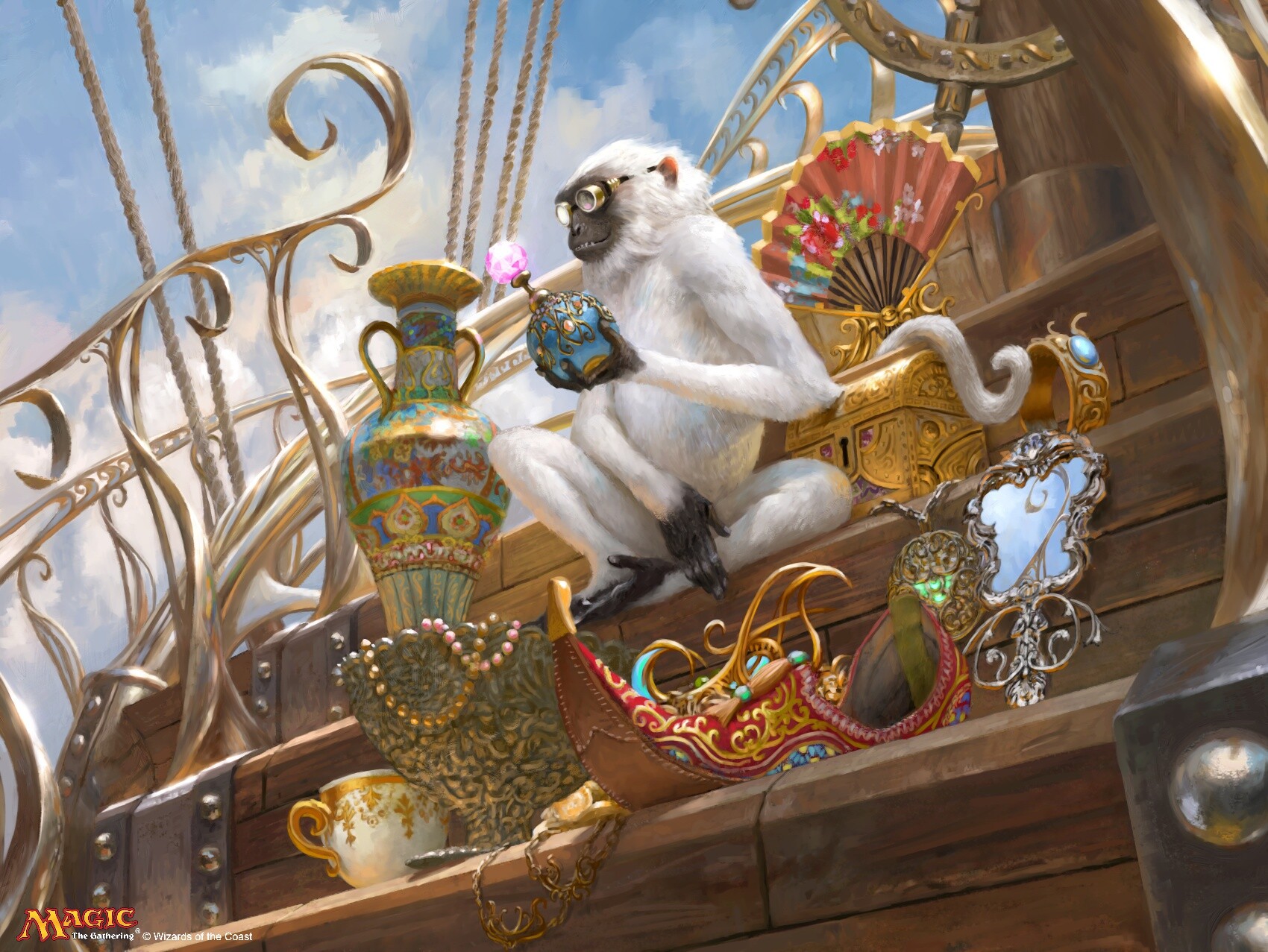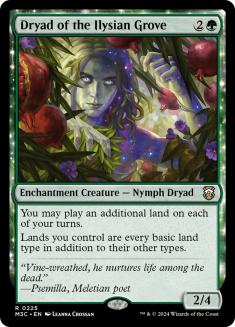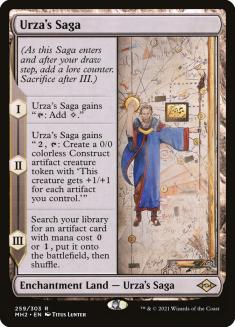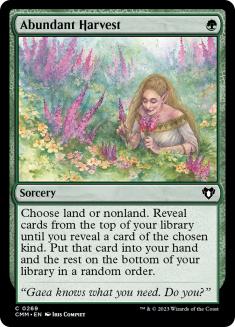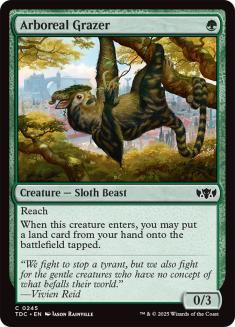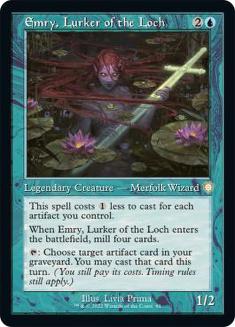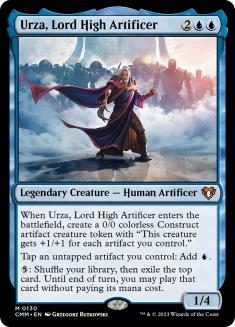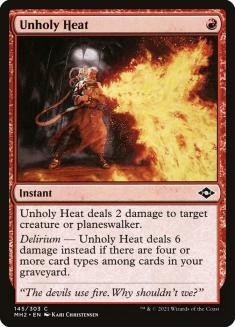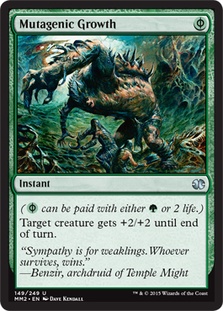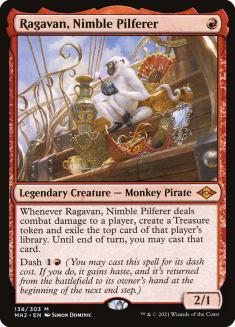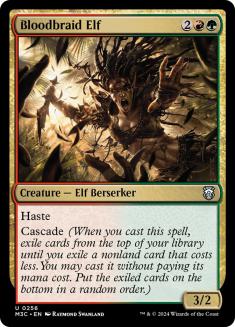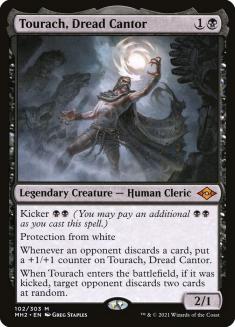Modern Horizons 2 has been released online for several weeks now, and we’re now seeing a defined metagame emerge. With such a powerful set, there were many format-changing cards to dissect and build around, and as such there were many new decks to be tuned.
The early days of the new format are thus much more wide open than those that follow, and we’re now seeing the new decks that have withstood the opening test emerge fully formed, as well as old decks that re-emerge to claim their lost metagame share from the days when we were all enamored with the new toys.
Of course, with such a powerful set, there are certainly strategies and cards that remain to be fully explored, and optimal lists to be found, but we’ve explored enough of the set to find a large enough array of consistently performing decks to constitute an established metagame. The days of simply brewing around a new card and seeing what works are brief, and they are now mostly gone.
So if you’re looking to succeed in Modern tournaments moving forward, you must prepare to combat this established metagame, and I’ve always found the easiest way to do that is to break it down into categories. These categories are defined by a card or strategy that forms a pillar of the new Modern metagame, and as of now I see four clear pillars of the new Modern.
So today I’m going to explain what these four pillars are, and which of the several decks that comprise that pillar is, in my opinion, the best. These are the decks you should be preparing against the most and should weigh most heavily in your final maindeck and sideboard choices. You should have a well-devised and practiced sideboard strategy against these decks, whereas you can get by with overlooking some of the more prominent Tier 2 strategies.
Primeval Titan
Creatures (11)
Lands (32)
Spells (17)

For years we’ve talked about the Big Mana category of decks in Modern, which encompasses not only Amulet Titan but also TitanShift, Mono-Green Tron, and Eldrazi Tron. At varying times the other three archetypes have been more popular and/or more successful, but over a large enough sample, it’s always Amulet Titan that comes out on top. And since the addition of Urza’s Saga, Amulet Titan has been far and away the most successful deck of the bunch.
At this point I’m ready to relegate the other three archetypes to Tier 2 status, which for me exemplifies a deck that is powerful enough to compete, but in order to be a strong choice it needs a specific metagame, whereas Tier 1 strategies are successful even when they’re being targeted. Eldrazi Tron has peeked through here and then because Chalice of the Void is well-positioned, but the rest of the deck is underpowered. Same for Mono-Green Tron, which can no longer rely on Karn Liberated catching you up from doing nothing before Turn 3 every game.
TitanShift is at least playing Primeval Titan, which is unquestionably the most powerful win condition for Big Mana decks in the history of Magic, but since the printing of Dryad of the Ilysian Grove, Amulet Titan has had all the tricks that TitanShift has, in addition to its normal avenues to victory.
The only question for Amulet Titan has been consistency. Once Upon a Time brought the deck back to prominence, but since that was banned the high fail rate for the deck has been a concern. But Urza’s Saga consistently finding Amulet of Vigor by Turn 3 or 4 has once again pushed the archetype up a notch. And not only that, it offers resilience by either distracting the opponent with a couple of Construct tokens or finding Expedition Map to access the toolbox of lands in the deck, from Cavern of Souls against control to Blast Zone against aggro to Bojuka Bog against graveyard decks. It may not do as much as it does in other decks, but what Urza’s Saga does for Amulet Titan is incredibly important.
The only question for Big Mana players in Modern is how to build your Amulet Titan deck. With Castle Garenbrig and Urza’s Saga becoming staples of the archetype, land counts are higher and there’s less room for flex cards. The list above plays Abundant Harvest over cards like Sakura Tribe-Scout or Karn, the Great Creator, and that’s what I prefer.
Sakura Tribe-Scout can make the deck more explosive but with Dryad largely overtaking Azusa, Lost but Seeking, it’s better to make your opponent’s cheap removal as weak as possible. And while Karn offers an alternate path to victory, it’s difficult to defend in this deck and Urza’s Saga is now providing additional resilience, so Karn is often unnecessary. Go for Abundant Harvest and just find your Titans and Dryads as often as possible.
I also like having exactly one maindeck copy of Arboreal Grazer because in combination with Amulet of Vigor and a bounceland it can turn an extra copy of Summoner’s Pact into a Lotus Petal of sorts, but as an individual card it has very high diminishing returns. You can sideboard in extra copies against aggro decks, where it’s valuable enough early to risk drawing superfluous copies.
This list has such a focused maindeck that the only card I’m willing to flex on is the second copy of Azusa, which depending on your metagame could become a maindeck Engineered Explosives to combat Asmor decks, a second Grazer if you expect a lot of aggro, or a Bojuka Bog for graveyard decks. Beyond that one slot, I wouldn’t play with this one too much, because you don’t want to mess with the deck’s consistency.
The sideboard has all the kinds of interaction you’d expect, but what I appreciate is that it isn’t overly concerned with the toolboxes. Singleton copies of the best interactive green creatures and lands, as well as a Tireless Tracker for attrition games, are all you need. Past that you should play the best options for interaction, like Force of Vigor and Dismember. Building your deck this way ensures that you strike the best balance between having consistent access to your interactive cards and the most power in those cards.
Amulet Titan has really always been the best Big Mana deck in Modern. But the gap between it and the rest of the pack is now as wide as it’s ever been. If you want to go over the top of your opponents, this is really your only option.
Asmoranomardicadaistinaculdacar
Creatures (22)
- 4 Street Wraith
- 4 Ovalchase Daredevil
- 3 Urza, Lord High Artificer
- 3 Emry, Lurker of the Loch
- 4 Asmoranomardicadaistinaculdacar
- 4 Thought Monitor
Lands (22)
Spells (16)

One of the newcomers to Modern since the release of Modern Horizons 2, Asmor quickly emerged as a contender, with the only question being how best to build around the powerful engine it forms alongside The Underworld Cookbook and Ovalchase Daredevil.
Early on it was green builds utilizing Feasting Troll King for explosiveness, and eventually incorporating Trail of Crumbs for some much-needed card advantage. But the community quickly saw the potential of pairing this engine with Emry, Lurker of the Loch and Urza, Lord High Artificer.
Both cards had featured in a dominant deck before, but fell to the fringe when Mox Opal was banned. Without the ability to ramp out Urza as quickly, you need to have a larger base of artifacts to effectively get a rebate on the steep four-mana cost. The Food engine does just that, making this a perfect match.
However, Izzet builds of the deck that emerged first, with Ragavan, Nimble Pilferer as an additional threat and way to generate quick mana. And while that explosiveness is attractive, this archetype doesn’t have the density of cheap interaction needed to consistently clear a path for Ragavan to connect. Too often it sits on the battlefield doing little to nothing. Instead, it’s better to supplement the blue cards with black interaction like Bone Shards, Fatal Push, and Thoughtseize.
This list, piloted by Cain Rianhard, an early adopter of the Dimir variant, splashes red for Abrade, Pyrite Spellbomb, and more powerful Engineered Explosives. That’s a great move for this metagame, but far from a core part of the deck.
The key to building this deck is to be minimalist in constructing the artifact toolbox. Between Aether Spellbomb and Pithing Needle you have enough interaction for opposing permanents, and Aether Spellbomb also protects your own creatures from removal. Mishra’s Bauble, a card you already want to max out on, offers enough card advantage, so there’s no need to add something like Chromatic Star. Shadowspear plays a key role in pressing your advantage with large Construct tokens as well as gaining life against aggro decks, and the Springleaf Drum ensures that your Urza’s Saga leaving after its third chapter won’t leave you lighter on mana if you don’t want it to.
There may be metagames where you want to maindeck a piece of graveyard hate, but now is not one of them. Relegating the Nihil Spellbomb to the sideboard is a disciplined decision. Same for Pyrite Spellbomb, which is simply too weak to maindeck but quite valuable in matchups where it’s effective.
The only change I want to make here is to play the second copy of Bone Shards in the maindeck rather than splitting it with Fatal Push. There are creatures like Murktide Regent and Stormwing Entity that Fatal Push doesn’t touch, and Bone Shards ensures you can cast your Asmors as early and often as possible. I’m willing to sacrifice the times where you don’t have an easy card to discard or sacrifice to realize those benefits.
These decks started as more explosive, graveyard-centric decks, but we’ve learned that the engine is powerful enough to take over a longer game, so it’s better to take a more controlling posture, and the Dimir shell is the best at enacting that gameplan, and does so with the least reliance on assembling the engine itself, since Emry, Urza, and black removal are powerful enough to win plenty of games by themselves.
Monastery Swiftspear
Creatures (16)
Lands (19)
Spells (25)

Prowess decks dominated the metagame in the months before Modern Horizons 2, but we didn’t see them in nearly the same numbers in the early days with the new set. Sometimes that’s a sign that the archetype is receding in the face of new, more powerful options, but in this case it was just lying dormant while everyone was excitedly playing with their new toys. It has since come back as a major player, though not at the same level it was previously.
It may have fallen even further were it not for the addition of Dragon’s Rage Channeler, which has supplanted Sprite Dragon in most lists. I’m all for the change, for two reasons. First, this deck trades on speed and efficiency. Izzet Prowess doesn’t have the same raw power as the other top decks in Modern, so any mana saved in the early-game is important. And second, the card selection from Dragon’s Rage Channeler is much needed here, since you’re often ahead early and looking for one or two good draws to close the game before your opponent stabilizes.
You could get more card selection from more blue cantrips, and many lists go that route by adding Serum Visions. But I’d rather have cards that affect the battlefield or end the game, since any mana spent spinning your wheels gives your opponent more time to react to your aggression. I’d suggest a list that plays more copies of Unholy Heat and Mutagenic Growth in the final flex slots.
Unholy Heat is the spell that Magmatic Sinkhole wanted to be. It’s easily castable early to answer Ragavans and Ignoble Hierarchs, but in the mid-game it handles a ton of threats that red decks often struggle with, from Tarmogoyf to Primeval Titan to Death’s Shadow, not to mention planeswalkers. It can be awkward to have a spell that you need a target to cast in your Prowess deck, but the card is powerful enough to make the risk of that awkwardness worth taking.
At this point Izzet Prowess is clearly the best Monastery Swiftspear deck. Dragon’s Rage Channeler makes the addition of Clever Lumimancer from going for a Boros build completely unnecessary, so the only real contender is the Mono-Red list featuring Obosh, the Preypiercer as a companion. That list is great at playing attrition games but sacrifices a lot in terms of speed. In Prowess-heavy metagames I think that trade-off is positive, but with powerful late-game cards like Asmor and Urza’s Saga taking up more space in the metagame, I’d rather play the more explosive variant in a big tournament metagame.
Ragavan, Nimble Pilferer
Creatures (17)
- 3 Kroxa, Titan of Death's Hunger
- 4 Dragon's Rage Channeler
- 2 Tourach, Dread Cantor
- 4 Ragavan, Nimble Pilferer
- 4 Dauthi Voidwalker
Lands (22)
Spells (21)

I wrote about the delayed emergence of Ragavan, Nimble Pilferer in Modern, but since then the card has defined midrange strategies. That may seem strange for a Jackal Pup, but that’s where Ragavan is at its best. Those decks have the disruption to protect it and clear the path for it to connect, so they consistently generate the greatest advantage with it.
Early on, blue decks took the lead with Ragavan, and it seemed to me like it was just a matter of the blue disruption being better than the black. But seeing Aspiringspike’s latest creation, Rakdos Delirium (Lurrus), emerge last weekend, I now see that the issue was that we weren’t building our black Ragavan decks correctly.
As good as Jund Midrange has been historically, it was always at its best when it was able to close games quickly. In fact that’s the most underrated aspect of Bloodbraid Elf. Closing speed is more important for Thoughtseize decks than Counterspell decks because Counterspell answers the top of your opponent’s deck while Thoughtseize does not. The only way for your Thoughtseize deck to play around those topdecks is to end the game.
So as Bloodbraid Elf and Tarmogoyf have grown weaker relative to the rest of the metagame, Jund Midrange decks haven’t had the necessary closing speed. Dragon’s Rage Channeler and Kroxa, Titan of Death’s Hunger, especially one powered out quickly because of surveil, offer that missing element. And the rest of the deck is also leaner, with the Lurrus restriction forcing the curve down and Unholy Heat replacing more expensive removal spells like Terminate or Dreadbore.
I’m also a fan of Tourach, Dread Cantor as the final threat where many players have opted for Dark Confidant, because the major sacrifice you make when building for Lurrus is powerful topdecks. Creatures with kicker ensure you have some of that topdeck equity that Thoughtseize decks are always looking for.
To me, this is easily the best black Ragavan deck out there, and right now the best Ragavan deck overall. But it’s also true that the metagame has been adapting more to blue Ragavan decks in recent weeks, and this deck has yet to prove itself when there’s a target on its back. Sanctifier en-Vec in particular looks like a major problem, and one that plenty of Modern decks can incorporate if they haven’t already.
I’d look to the Izzet Delver deck if you’d rather stick with counterspells, though please omit the card Delver of Secrets. Dragon’s Rage Channeler and Ragavan are enough when it comes to cheap threats, and Delver just isn’t a good card in a format with more removal and no Daze. The major draw here is Murktide Regent, and you need enough cheap spells in order to enable it. Murktide Regent is nigh-unkillable right now with Path to Exile at an all-time low and new spells like Unholy Heat and Prismatic Ending falling short. I’d start with the following list:
Creatures (12)
Lands (18)
Spells (30)
- 4 Lightning Bolt
- 4 Counterspell
- 3 Serum Visions
- 4 Mishra's Bauble
- 1 Spell Pierce
- 4 Thought Scour
- 2 Force of Negation
- 4 Expressive Iteration
- 4 Unholy Heat
Sideboard

These two decks are neck-and-neck for the title of best Ragavan deck in Modern, and the competition will be settled by how each reacts to a prepared metagame. Both are versatile in their ability to win both early and late, and you’ll want to stay on top of the metagame and come with a well-tuned list week after week if you want to succeed.
The metagame that has emerged in Modern with Modern Horizons 2 is a great balance of old and new, along with a good balance of strategies. The Monastery Swiftspear pillar decks are your aggro, Ragavan the midrange, Primeval Titan the ramp, and Asmor the control (as awkward-looking a control deck it may be). So no matter how you like to play, there’s a proven strategy you can look to.
Of course, there’s also a wealth of Tier 2 strategies that are more than capable of taking down a given tournament. From Golgari Yawgmoth to Mono-White Hammer to Living End, you can still count on Modern to offer up some off-the-wall decks that are more than competitive. I suspect we’ll see even more of these types of decks emerge as players continue to iterate on underplayed archetypes enabled by Modern Horizons 2, and do so with the idea of attacking this metagame in mind.
The original Modern Horizons ushered in an era where Modern was dominated by broken strategies for months, but the second go-around is bringing the format to a great position. It’s the perfect time to get into, or back into, Modern.

